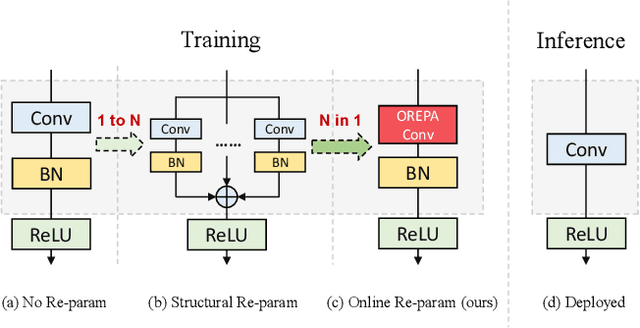Jiashen Hua
Online Convolutional Re-parameterization
Apr 02, 2022



Abstract:Structural re-parameterization has drawn increasing attention in various computer vision tasks. It aims at improving the performance of deep models without introducing any inference-time cost. Though efficient during inference, such models rely heavily on the complicated training-time blocks to achieve high accuracy, leading to large extra training cost. In this paper, we present online convolutional re-parameterization (OREPA), a two-stage pipeline, aiming to reduce the huge training overhead by squeezing the complex training-time block into a single convolution. To achieve this goal, we introduce a linear scaling layer for better optimizing the online blocks. Assisted with the reduced training cost, we also explore some more effective re-param components. Compared with the state-of-the-art re-param models, OREPA is able to save the training-time memory cost by about 70% and accelerate the training speed by around 2x. Meanwhile, equipped with OREPA, the models outperform previous methods on ImageNet by up to +0.6%.We also conduct experiments on object detection and semantic segmentation and show consistent improvements on the downstream tasks. Codes are available at https://github.com/JUGGHM/OREPA_CVPR2022 .
Learning to Generate Content-Aware Dynamic Detectors
Dec 08, 2020



Abstract:Model efficiency is crucial for object detection. Mostprevious works rely on either hand-crafted design or auto-search methods to obtain a static architecture, regardless ofthe difference of inputs. In this paper, we introduce a newperspective of designing efficient detectors, which is automatically generating sample-adaptive model architectureon the fly. The proposed method is named content-aware dynamic detectors (CADDet). It first applies a multi-scale densely connected network with dynamic routing as the supernet. Furthermore, we introduce a course-to-fine strat-egy tailored for object detection to guide the learning of dynamic routing, which contains two metrics: 1) dynamic global budget constraint assigns data-dependent expectedbudgets for individual samples; 2) local path similarity regularization aims to generate more diverse routing paths. With these, our method achieves higher computational efficiency while maintaining good performance. To the best of our knowledge, our CADDet is the first work to introduce dynamic routing mechanism in object detection. Experiments on MS-COCO dataset demonstrate that CADDet achieves 1.8 higher mAP with 10% fewer FLOPs compared with vanilla routing strategy. Compared with the models based upon similar building blocks, CADDet achieves a 42% FLOPs reduction with a competitive mAP.
 Add to Chrome
Add to Chrome Add to Firefox
Add to Firefox Add to Edge
Add to Edge